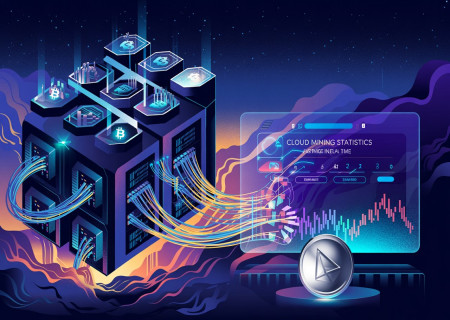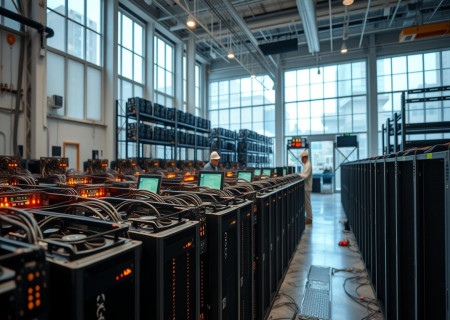
- April 22, 2025
- 6 months ago
Top Bitcoin Mining Hardware for 2025: Key Features for Optimized Mining Profits
The world of Bitcoin mining continues to evolve rapidly in 2025. With advancements in technology and hardware, miners have more opportunities to enhance their crypto mining profitability. However, selecting the best equipment remains a crucial decision that directly impacts your earnings. This blog explores the best Bitcoin mining machines of the year, providing a comprehensive breakdown of hash rates, power efficiency, and return on investment (ROI) to help you make informed choices.
The Changing Landscape of Bitcoin Mining in 2025
The Bitcoin mining scene in 2025 offers both opportunity and challenges. While new hardware keeps pushing performance boundaries, rising energy costs and increasing mining difficulty add pressure to miners. Navigating these hurdles requires a focus on Bitcoin mining hardware efficiency and cost-effectiveness.
Current Mining Challenges
- Higher Mining Difficulty: Increased computational power is needed to solve equations.
- Rising Energy Costs: Operating expenses grow as energy prices climb.
| Challenge | Impact on Miners |
|---|---|
| Increased Difficulty | Requires higher computational power |
| Rising Energy Costs | Leads to greater operational costs |
Why Hardware Selection Matters for Crypto Mining Success
To stay competitive and profitable, choosing the right Bitcoin mining hardware is essential. Key hardware features, such as hash rate, power efficiency, and cost, play vital roles in determining overall profitability.
| Hardware Feature | Importance |
|---|---|
| Hash Rate | Directly affects mining revenue |
| Power Efficiency | Reduces operational costs |
| Equipment Cost | Impacts initial investment |
Evaluating Bitcoin Mining Machines Using Key Metrics
Understanding Hash Rate
A machine's hash rate measures its computational power, i.e., the number of calculations it performs per second. Higher hash rates improve mining rewards and performance. For example, machines with a hash rate above 200 TH/s are ideal for serious miners in 2025.
Assessing Power Efficiency (W/TH)
Power efficiency impacts your operational costs significantly. Efficient mining hardware consumes less energy while maintaining high output, such as machines with ratios like 15 J/TH.
Calculating ROI
ROI is the ultimate measure of a mining machine's value. By factoring in the initial cost, energy usage, and Bitcoin price fluctuations, miners can estimate profitability. Dedicated mining calculators simplify this process.
Best Bitcoin Mining Machines of 2025
1. Bitmain Antminer S21 Pro
- Hash Rate: 200 TH/s
- Power Consumption: 3500W
- Efficiency: 17.5 J/TH
Known for setting a new standard in mining, the S21 Pro has shown up to a 30% improvement in profits for users.
2. MicroBT Whatsminer M50S+
- Hash Rate: 211 TH/s
- Power Consumption: 3220W
- Efficiency: 15.2 J/TH
With consistent performance across diverse conditions, the M50S+ remains a top choice in 2025.
3. Canaan Avalon A1466
- Hash Rate: 183 TH/s
- Power Consumption: 3300W
- Efficiency: 17.8 J/TH
The Avalon A1466 strikes the perfect balance between performance and affordability.
4. iPollo B2 Ultra
- Hash Rate: 195 TH/s
- Power Consumption: 3100W
- Efficiency: 15.9 J/TH
Affordable and efficient, the iPollo B2 Ultra stands out for its optimized design.
How to Choose the Best Bitcoin Mining Hardware in 2025
Define Your Budget and Power Needs:
Assess your electricity costs, initial investment, and budgetary constraints before making a decision.
Predict Earnings Using Mining Calculators:
Hash rate, power efficiency, and operational costs can be analyzed to estimate earnings.
Check Warranty and Support:
Reliable after-sales support ensures operational continuity.
Ensure Cooling Systems Are Adequate:
Efficient cooling improves hardware lifespan and reduces electricity costs.
Consider Noise Levels and Space Requirements:
Larger setups need proper spacing and attention to noise regulation.
Future-Proofing Your Mining Investment
As Bitcoin mining evolves, focusing on future trends and upgrades is crucial to staying ahead in a competitive field.
Adopting Advanced Mining Hardware:
Innovative machines like the Bitmain Antminer S21 Pro and MicroBT Whatsminer M50S+ represent the pinnacle of efficiency and hashing power.
Preparing for Bitcoin Halving Events:
Bitcoin halvings reduce mining rewards, making efficiency and low costs increasingly important.
| Model | Hash Rate | Power Efficiency |
|---|---|---|
| Bitmain Antminer S21 Pro | 200 TH/s | 20 J/TH |
| MicroBT Whatsminer M50S+ | 211 TH/s | 18 J/TH |
Final Thoughts
Selecting the best Bitcoin mining machines involves evaluating hash rate, power efficiency, and ROI. With the right hardware, miners can overcome challenges like rising energy costs and stay profitable in 2025. Whether you choose the Bitmain Antminer S21 Pro or the MicroBT Whatsminer M50S+, focus on features that optimize your crypto mining profitability.
Staying informed about advancements and ROI metrics will help you remain competitive and successful in the dynamic world of Bitcoin mining.




